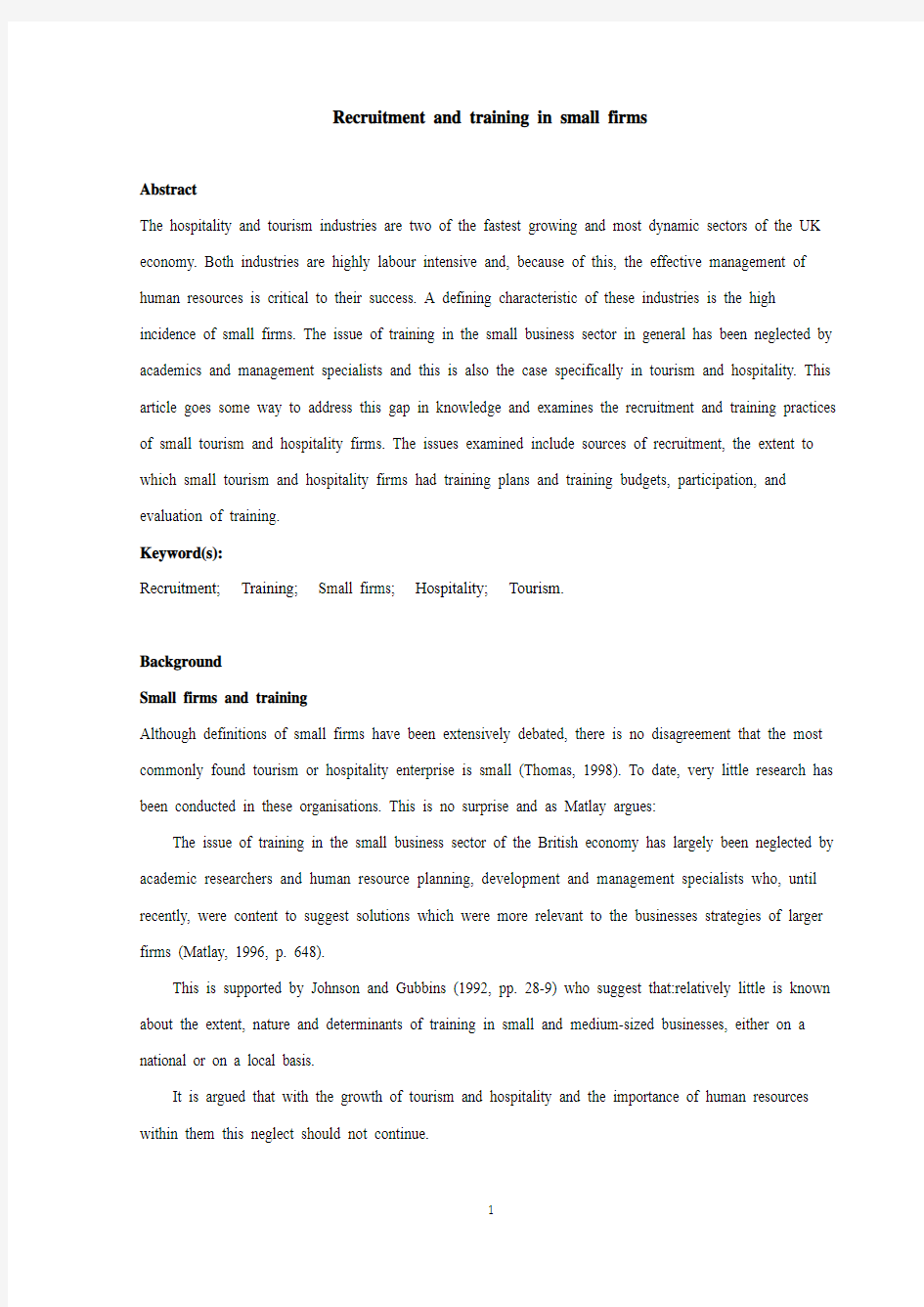小企业的招聘与培训人力资源外文文献及翻译大学论文

- 1、下载文档前请自行甄别文档内容的完整性,平台不提供额外的编辑、内容补充、找答案等附加服务。
- 2、"仅部分预览"的文档,不可在线预览部分如存在完整性等问题,可反馈申请退款(可完整预览的文档不适用该条件!)。
- 3、如文档侵犯您的权益,请联系客服反馈,我们会尽快为您处理(人工客服工作时间:9:00-18:30)。
Recruitment and training in small firms
Abstract
The hospitality and tourism industries are two of the fastest growing and most dynamic sectors of the UK economy. Both industries are highly labour intensive and, because of this, the effective management of human resources is critical to their success. A defining characteristic of these industries is the high incidence of small firms. The issue of training in the small business sector in general has been neglected by academics and management specialists and this is also the case specifically in tourism and hospitality. This article goes some way to address this gap in knowledge and examines the recruitment and training practices of small tourism and hospitality firms. The issues examined include sources of recruitment, the extent to which small tourism and hospitality firms had training plans and training budgets, participation, and evaluation of training.
Keyword(s):
Recruitment; Training; Small firms; Hospitality; Tourism.
Background
Small firms and training
Although definitions of small firms have been extensively debated, there is no disagreement that the most commonly found tourism or hospitality enterprise is small (Thomas, 1998). To date, very little research has been conducted in these organisations. This is no surprise and as Matlay argues:
The issue of training in the small business sector of the British economy has largely been neglected by academic researchers and human resource planning, development and management specialists who, until recently, were content to suggest solutions which were more relevant to the businesses strategies of larger firms (Matlay, 1996, p. 648).
This is supported by Johnson and Gubbins (1992, pp. 28-9) who suggest that:relatively little is known about the extent, nature and determinants of training in small and medium-sized businesses, either on a national or on a local basis.
It is argued that with the growth of tourism and hospitality and the importance of human resources within them this neglect should not continue.
Research conducted in hospitality and tourism firms of all sizes has discovered that informality and a relatively unsophisticated management style characterise the approach taken towards recruitment and training (Goldsmith et al., 1997; Price, 1994; Lucas, 1995; Baum, 1995). Research on recruitment and training in small firms in general (Jameson, 1998) has also indicated that an informal approach towards the management of human resources is the norm in these firms. One of the major themes in small business literature has been the examination of the informality of relations between employers and employees. A correlation has been found to exist between the size of firm and level of formality in various sectors of the economy (see, for example, Scott et al. (1989); Curran et al. (1993)). Research conducted specifically in hospitality firms (Price, 1994, p. 49) found that:
one of the main findings from the survey was the importance of the relationship between establishment size and employment practices … there was a strong correlation between size and the extent to which establishments had introduced personnel policies, procedures or other arrangements which met the requirements of employment law.
The significance of this relationship cannot be underestimated and must be borne in mind when interpreting the results on recruitment and training in the small firms in the sample.
Any meaningful analysis of recruitment and training cannot be undertaken without some understanding of the labour market within which small tourism and hospitality firms operate. Much effort has been expended developing theoretical models of the labour market. As far as the tourism and hospitality industries are concerned one of the most useful theories is dual labour market theory. Goldsmith et al. (1997) summarize this succinctly. Dual labour market theory proposes that the total labour market can be segmented. One section is the primary labour market, where jobs tend to be supplied by large, highly profitable firms with a high capital to labour ratio and high productivity. Here, production is usually large scale with high investment in technology. Employment in these firms is normally stable with relatively high skill and wage levels. In this context, there are normally opportunities for training. The secondary labour market is normally characterised by small firms with low capital to labour ratio, low productivity and small scale production. In these firms, wage and skill levels tend to be low, employment is unstable and training opportunities are usually limited. Small tourism and hospitality firms normally tend to operate within the secondary labour market.
There are obvious relationships between recruitment and training. One relationship is where training can provide solutions to problems in the labour market. Campbell and Baldwin (1993) suggest that in many
